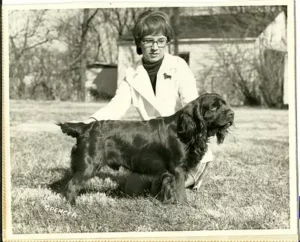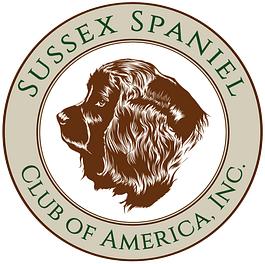Breed History
History of the Sussex Spaniel Breed in America
 The following excerpt (taken from Sussex Spaniel, A Complete and Reliable Handbook, John Robert Lewis, Jr.) has been reprinted.
The following excerpt (taken from Sussex Spaniel, A Complete and Reliable Handbook, John Robert Lewis, Jr.) has been reprinted.
The history of the Sussex Spaniel in America is older than the American Kennel Club itself. The first Sussex Spaniel registration in North America appears in Volume I of the National American Kennel Club Stud Book (1878). This dog, Jack (alias Toby), was owned by Capt. C. E. McMurdo of New Brunswick, Canada. Later, Capt. McMurdo moved to Campbell County, Virginia, and finally to Shadwell, Virginia.
Although there were a couple of Sussex entered into the AKC’s Stud Book in the late 1800s and early 1900s, there is no record of any litter produced by them. Additional imported Sussex Spaniels entered the United States in the early 1920’s. From these imports, breeders established an American line of Sussex that endured until in the 1950’s.
The majority of Sussex puppies born during the first half of the 1930’s were registered in the Field Dog Stud Book and not the American Kennel Club Studbook. Between 1936 and 1940, Elmina Brewster, who later appeared under her married name “Elmina Sewall,” imported some of the best stock available in England. Mrs. Sewall went on to breed seven litters over the next several years under the “Tarralong” prefix. Col. and Mrs. Edmund Russel of Rumford, Rhode Island, also played an important role in Sussex history during the 1940’s. There were only five other people who bred Sussex in America during that decade: Harry Bradford, Dr. & Mrs. Larrabee, Daniel Farrell, and Boyd E. Hayward.
Ironically, by the end of World War II, there were more Sussex Spaniels alive in the U.S. than in the United Kingdom. Tragically, there is no link between the American-bred Sussex of today and those bred from dogs imported prior to the war. The last litter of the Sussex Spaniels descended from the dogs of the 1920’s and 1930’s was born on April 24, 1951. The only other Sussex Spaniel litter whelped during the 1950’s occurred in 1957. This litter was from two imports that arrived a couple of years prior to that. Of the few Sussex imported during the 1960’s, only two have relevance in today’s pedigrees. In 1969, Nadine Prokop of Richland, Washington, imported Doric of Creswelshaw. In the same year, Milt and Eunice Gies imported Sedora Quettadene Damon.
The revival of the breed in America began in earnest in the early 1970’s. It was during this time that most of the Sussex that were to become the foundation of the breed in America made the journey from England. George and Marcia Deugan began their Ziyadah Kennel of Sussex Spaniels in 1970 with the importation of Ch. Oakmoss Witch, CD. The following year the Deugans added the litter brothers Ch. Sedora Galega and Ch. Sedora Galingale. In early 1972, the Deugans bred Galega to Witch and the resulting litter, born March 2 1972, became the first Sussex puppies to be born in the US since 1957. This was the most influential litter born during the 1970’s. The Ziyadah Kennel has played a dominant role in ensuring the survival of the breed. William and Margaret Reid imported Ch. Sharland Sussex Mayfly and Sharland Sussex Gold and two became the cornerstone of the Wilred Kennel. The first of the Wilred Sussex litters arrived on August 19, 1972. Ch. Wilred Country Gentleman and Ch. Wilred Royal Velvet both came from that litter.
John Robert “Bobby” Lewis imported Ch. Oldholbans Fionnlagh in September 1972, and Ch. Fourclovers Lapwai early 1973. Fionnlagh whelped the first litter of Sussex born under the “Lexxfield” name on March 18, 1973. Ch. Sedora Quettadene Damon was the sire. Fionnlagh‘s second litter by Ch. Fourclovers Lapwai arrived on March 22, 1974. These two litters formed the foundation of the Lexxfield line. In many rare breeds, the breeders of one or two litters play a significant role. This is the case with Sussex. The Sussex Spaniel has always been fortunate in having one of two long-term breeders who have helped the breed through difficult times. Owners who bred only one or two litters also have contributed significantly to the survival of the breed both in America and overseas.
